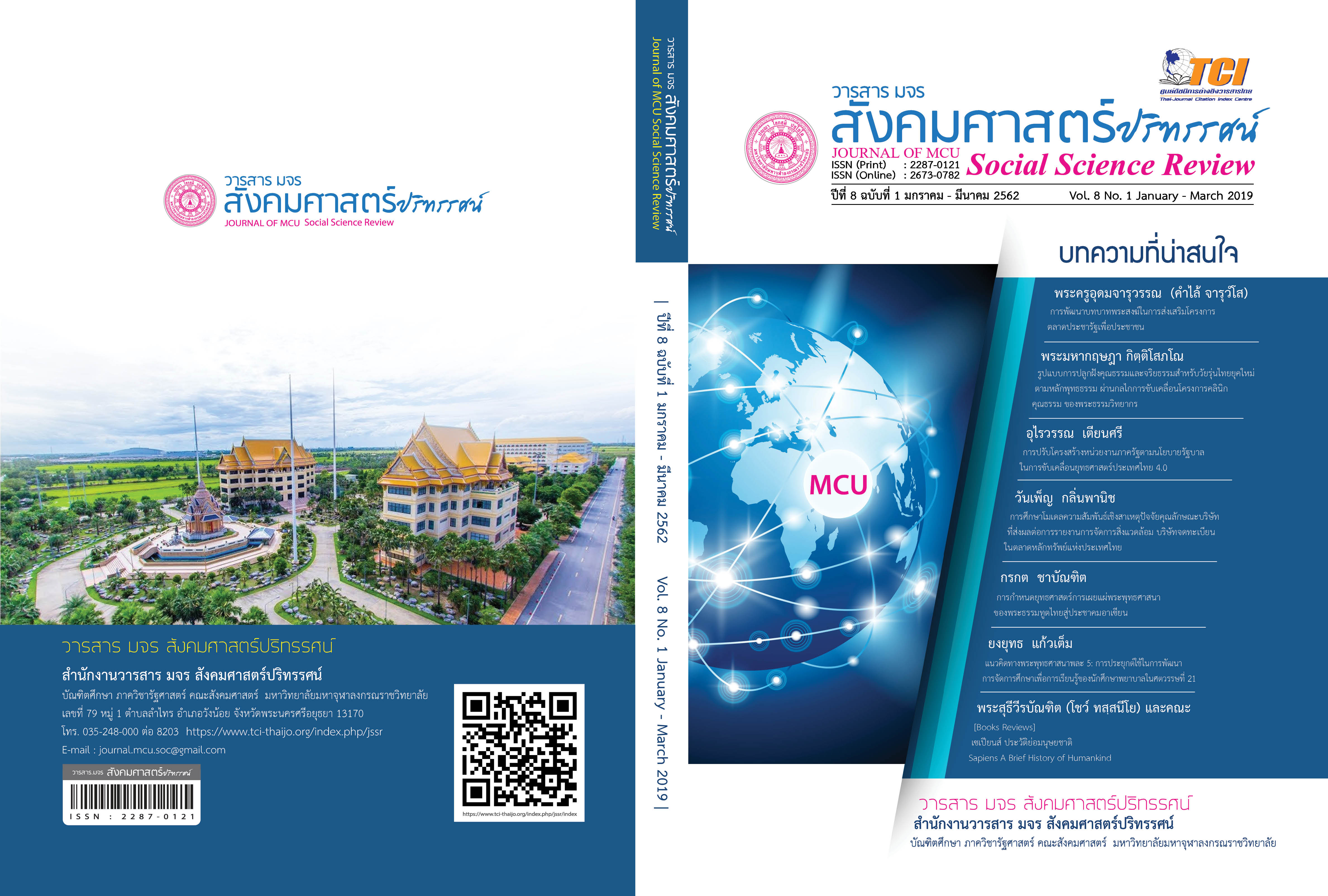การศึกษาโมเดลความสัมพันธ์เชิงสาเหตุปัจจัยคุณลักษณะบริษัทที่ส่งผลต่อการรายงานการจัดการสิ่งแวดล้อม บริษัทจดทะเบียนในตลาดหลักทรัพย์แห่งประเทศไทย
คำสำคัญ:
การจัดการด้านสิ่งแวดล้อมรายงานแบบจำลองความสัมพันธ์บทคัดย่อ
การวิจัยครั้งนี้มีวัตถุประสงค์เพื่อศึกษาความสัมพันธ์ของปัจจัยที่คุณลักษณะบริษัทที่ส่งผลต่อการรายงานการจัดการสิ่งแวดล้อมของ บริษัท จดทะเบียนในตลาดหลักทรัพย์แห่งประเทศไทยงานวิจัยนี้ได้ศึกษาข้อมูลจากรายงานประจำปี (แบบ 56-1) งบการเงินประจำปีและงบการเงินปี พ.ศ. 2558 โดยมีกลุ่มตัวอย่างจาก 362 บริษัทข้อมูลของแบบจำลองสมการโครงสร้างถูกวิเคราะห์ด้วยโปรแกรมทางสถิติที่เรียกว่า Multiple Indicators and Multiple Cuses (MIMIC) Model
ผลการทดสอบความสอดคล้องของรูปแบบความสัมพันธ์เชิงสาเหตุของปัจจัยด้านคุณลักษณะขององค์กร (CHA) ที่มีอิทธิพลต่อรายงานการจัดการด้านสิ่งแวดล้อม (EVM) พบว่าแบบจำลองตามสมมติฐานสอดคล้องกับข้อมูลเชิงประจักษ์ด้วยการทดสอบทางสถิติต่อไปนี้ 16.22 Chi Square, 0.062 ความน่าจะเป็นทางสถิติ (p), 9 องศาอิสระ (df), 1.80 สำหรับค่า²2 / 0.047 RMSEA, 0.033 SRMR, 0.99 GFI, 0.98 CFI และ 0.96 AGFI นอกจากนี้ตัวแปรคุณลักษณะของบริษัท มีอิทธิพลทางบวกโดยตรงต่อการจัดการด้านสิ่งแวดล้อม (EVM) อย่างมีนัยสำคัญทางสถิติที่ระดับ 0.01 โดยมีค่าสัมประสิทธิ์อิทธิพลเท่ากับ 0.26
เอกสารอ้างอิง
Burritt, R.L And Saka, C. (2006). Environmental Management Accounting Applications Andeco-Efficiency: Case Studies from Japan. Journal of Cleaner Production (14) : 1262 - 1275.
Deegan, D. (2003). Introduction:The Legitimizing Effect of Social and Environmental Disclosures: A Theoretical Foundation. Accountability Auditing & Accountability, 5 : 282-311.
Gorton, Gary B., Lixin Huang and Qiang Kang (2010). The Limitations of Stock Marketefficiency: Price Informativeness and CEO Turnover. Working Paper, Yale University
Gustavo Tanaka Nakasone (2015). Environmental Accounting in Peru: A Proposal Based on Thesustainability Reporting in The Mining, Oil And Gas Industries. Contabilidad Y Negocios, 10 (19), Pp. 6 – 26.
Hair, J. F., Anderson, R. E., Tatham, R. L., & Black, W. C. (1998). Multivariate Data Analysis (5th Ed.). Upper Saddle River, NJ: Prentice Hall.
Jalaludin, D., Sulaiman, M., & Ahmad, N. N. N. (2011). Understanding Environmental Management Accounting (EMA) Adoption: A New Institutional Sociology Perspective. Social Responsibility Journal, 7(4), Pp. 540 − 557.
Katherine Christ And Roger Leonard Burritt (2013).Critical Environmental Concerns In Wine Production: An Integrative Review. Journal Of Cleaner Production, 53, PP. 232 – 242.
Masanet Llodra, M. J. (2006). Environmental Management Accounting: A Case Studyresearch On Innovative Strategy. Journal Of Business Ethics, 68: 393 – 408
Neelam Singh, Suresh Jain And Prateek Sharma (2015). Motivations For Implementing Environmental Management Practices In Indian Industries. Ecological Economics, 109 : 1 – 8.
Staniskis, K. And Stasiskiene, Z (2006). Environmental Management Accounting In Lithuania: Exploratory Study Of Current Practices, Opportunities And Strategic Intents. Journal Of Cleaner Production, 14 :1252 -1261.
Stock Exchange Of Thailand , Corporate Social Responsibility Institute (CSRI), Thaipat Institute. (2012). Guidelines For The Preparation Of Sustainability Reports, Bangkok: Edition 1.
Sukcharoensin, S. (2003). Essays On Corporate Governance, Outside Directors, And Firmperformance. Unpublished Dissertation, The JDBA, Bangkok.
ดาวน์โหลด
เผยแพร่แล้ว
รูปแบบการอ้างอิง
ฉบับ
ประเภทบทความ
สัญญาอนุญาต
ลิขสิทธิ์ (c) 2019 วารสาร มจร สังคมศาสตร์ปริทรรศน์

อนุญาตภายใต้เงื่อนไข Creative Commons Attribution-NonCommercial-NoDerivatives 4.0 International License.
เพื่อให้เป็นไปตามกฎหมายลิขสิทธิ์ ผู้นิพนธ์ทุกท่านต้องลงลายมือชื่อในแบบฟอร์มใบมอบลิขสิทธิ์บทความให้แก่วารสารฯ พร้อมกับบทความต้นฉบับที่ได้แก้ไขครั้งสุดท้าย นอกจากนี้ ผู้นิพนธ์ทุกท่านต้องยืนยันว่าบทความต้นฉบับที่ส่งมาตีพิมพ์นั้น ได้ส่งมาตีพิมพ์เฉพาะในวารสาร มจร สังคมศาสตร์ปริทรรศน์ เพียงแห่งเดียวเท่านั้น หากมีการใช้ภาพหรือตารางหรือเนื้อหาอื่นๆ ของผู้นิพนธ์อื่นที่ปรากฏในสิ่งตีพิมพ์อื่นมาแล้ว ผู้นิพนธ์ต้องขออนุญาตเจ้าของลิขสิทธิ์ก่อน พร้อมทั้งแสดงหนังสือที่ได้รับการยินยอมต่อบรรณาธิการ ก่อนที่บทความจะได้รับการตีพิมพ์ หากไม่เป็นไปตามข้อกำหนดเบื้องต้น ทางวารสารจะถอดบทความของท่านออกโดยไม่มีข้อยกเว้นใดๆ ทั้งสิ้น





